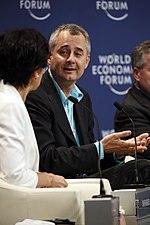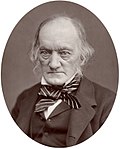The Bianconi–Barabási model is named after its inventors Ginestra Bianconi and Albert-László Barabási. This model is a variant of the Barabási–Albert...
22 KB (3,121 words) - 19:54, 12 October 2024
its degree. The BA model claims that this explains the preferential attachment probability rule. Later, the Bianconi–Barabási model works to address this...
22 KB (2,747 words) - 19:54, 12 October 2024
multilayer and higher-order networks, and in particular for the Bianconi–Barabási model of growing of complex networks and for the Bose–Einstein condensation...
6 KB (430 words) - 14:42, 4 October 2024
Ginestra Bianconi and Albert-László Barabási proposed a new model called Bianconi-Barabási model, a variant to the Barabási-Albert model (BA model), where...
6 KB (863 words) - 15:34, 13 November 2023
Scale-free network (redirect from Generalized scale-free model)
Graph of connected web pages Barabási–Albert model – Scale-free network generation algorithm Bianconi–Barabási model – model in network sciencePages displaying...
53 KB (6,723 words) - 03:31, 26 March 2024
social networks. Some modeling alternatives include Barabási–Albert model and Watts and Strogatz model. These alternative models are not percolation processes...
18 KB (2,627 words) - 03:30, 26 March 2024
preferential attachment family of models, such as the Barabási–Albert (BA) model. (On the other hand, the Barabási–Albert model fails to produce the high levels...
11 KB (1,613 words) - 08:39, 27 November 2023
series held since 2006. Barabási was born to an ethnic Hungarian family in Cârța, Harghita County, Romania. His father, László Barabási, was a historian, museum...
35 KB (3,601 words) - 14:48, 22 September 2024
hierarchical models nodes with more links are expected to have a lower clustering coefficient. Moreover, while the Barabási-Albert model predicts a decreasing...
9 KB (1,192 words) - 03:30, 26 March 2024
multilayer and higher-order networks, and in particular for the Bianconi–Barabási model of growing of complex networks and for the Bose–Einstein condensation...
30 KB (2,883 words) - 13:32, 14 March 2024
Global cascades models are a class of models aiming to model large and rare cascades that are triggered by exogenous perturbations which are relatively...
8 KB (1,087 words) - 20:55, 30 August 2021
networks have been modelled by DCM, such as neural networks, finance and social networks. Network Science by Albert-László Barabási. Newman, Mark (2010-03-25)...
21 KB (3,077 words) - 14:09, 4 October 2024
which in effect makes the Watts–Strogatz model a random network. The Barabási–Albert model is a random network model used to demonstrate a preferential attachment...
73 KB (10,572 words) - 20:40, 1 November 2024
Exponential Random Graph Models (ERGMs) are a family of statistical models for analyzing data from social and other networks. Examples of networks examined...
23 KB (3,539 words) - 19:23, 16 October 2024
Boolean network (redirect from RBN model)
synchronously or asynchronously. Boolean networks have been used in biology to model regulatory networks. Although Boolean networks are a crude simplification...
25 KB (2,832 words) - 15:01, 21 September 2024
The stochastic block model is a generative model for random graphs. This model tends to produce graphs containing communities, subsets of nodes characterized...
17 KB (2,073 words) - 19:38, 23 June 2024
Random graph (section Models)
refers almost exclusively to the Erdős–Rényi random graph model. In other contexts, any graph model may be referred to as a random graph. A random graph is...
15 KB (2,197 words) - 11:03, 2 November 2024
In applied mathematics, the soft configuration model (SCM) is a random graph model subject to the principle of maximum entropy under constraints on the...
5 KB (983 words) - 19:25, 15 January 2024
Percolation theory (section Different models)
numerical methods to analyze this model. Broadbent and Hammersley introduced in their article of 1957 a mathematical model to model this phenomenon, that is percolation...
28 KB (3,368 words) - 22:18, 29 October 2024
as models to understand seizures. Barabási–Albert model – Scale-free network generation algorithm Climate as complex networks – Conceptual model to generate...
38 KB (4,646 words) - 16:45, 15 May 2024
original on 2013-12-18. Retrieved 2013-12-08. "NetworkScience". Albert-László Barabási. Archived from the original on 2020-03-05. Retrieved 2020-03-20. Clauset...
21 KB (2,962 words) - 18:30, 21 October 2024
Watts, Albert-László Barabási, Peter Bearman, Nicholas A. Christakis, James H. Fowler, and others, developing and applying new models and methods to emerging...
68 KB (7,586 words) - 16:45, 29 October 2024
arXiv:1309.7233. doi:10.1093/comnet/cnu016. S2CID 11390956. Boccaletti, S.; Bianconi, G.; Criado, R.; del Genio, C. I.; Gómez-Gardeñes, J.; Romance, M.; Sendiña-Nadal...
55 KB (6,915 words) - 07:24, 25 August 2024
Network topology (redirect from Networking Models)
theory wherein communicating devices are modeled as nodes and the connections between the devices are modeled as links or lines between the nodes. Physical...
40 KB (5,232 words) - 08:18, 19 October 2024
Topology Random graph Erdős–Rényi Barabási–Albert Bianconi–Barabási Fitness model Watts–Strogatz Exponential random (ERGM) Random geometric (RGG) Hyperbolic...
11 KB (1,161 words) - 23:20, 6 January 2024
In network science, the activity-driven model is a temporal network model in which each node has a randomly-assigned "activity potential", which governs...
3 KB (464 words) - 14:01, 9 January 2024
Disparity filter algorithm of weighted network (section The null model of normalized weight distribution)
represents the normalized weight of each link in the null model. Consecutively, and based on the null model, we can derive that the normalized weight distribution...
8 KB (985 words) - 15:03, 25 October 2024
calculated analytically for two models of networks: the random graph of Erdős and Rényi BA Model (Barabási-Albert model) In the ER model, since edges are placed...
13 KB (1,976 words) - 11:43, 15 March 2024
9j8830H. doi:10.1371/journal.pone.0108830. PMC 4188586. PMID 25290670. Barabási AL, Gulbahce N, Loscalzo J (January 2011). "Network medicine: a network-based...
31 KB (3,415 words) - 11:45, 26 August 2024
hypercubes. Some models of growing networks that produce scale-invariant degree distributions are the Barabási–Albert model and the fitness model. In a network...
19 KB (2,493 words) - 09:07, 5 June 2024











